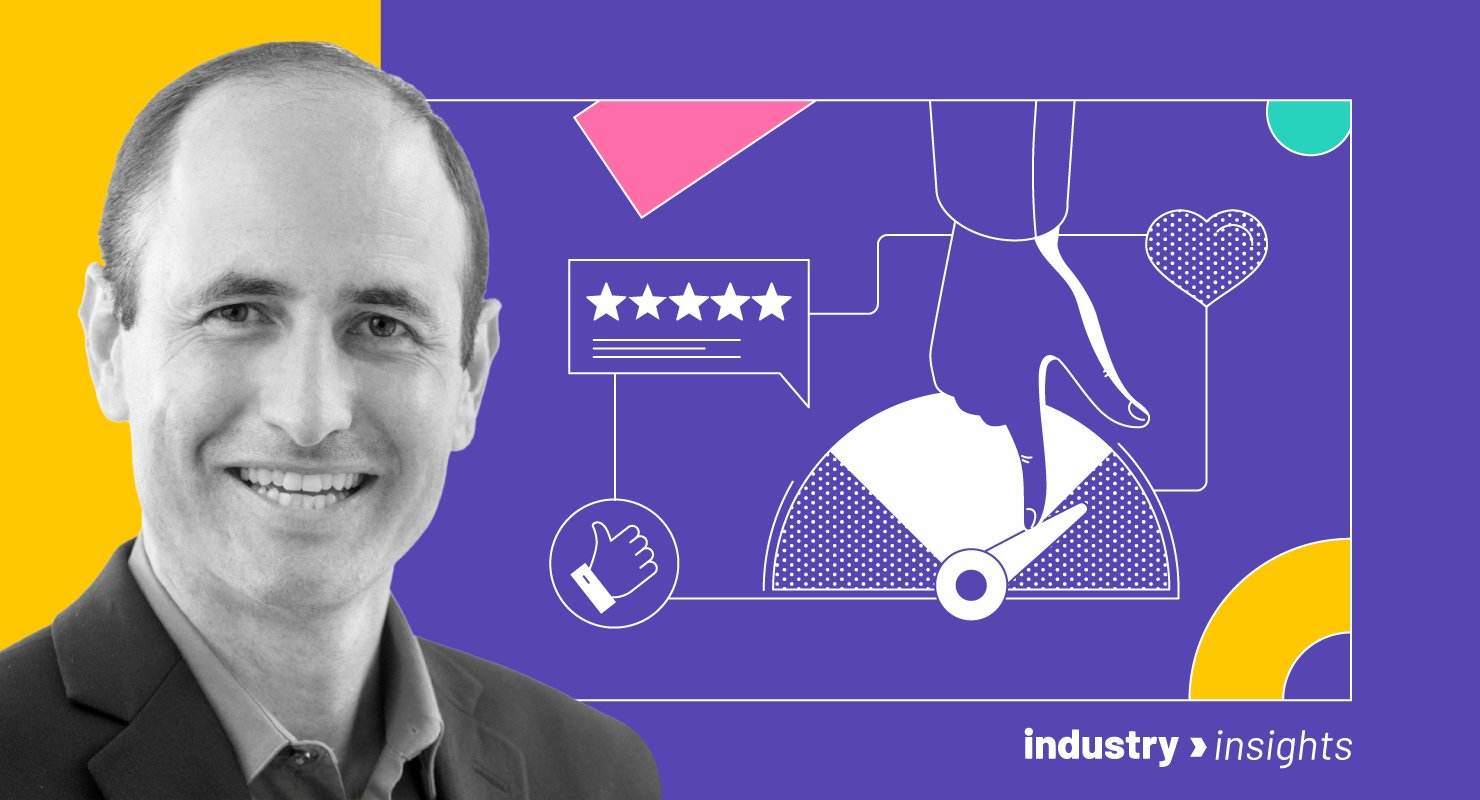August 2, 2023
.jpg?width=400&height=150&name=Nitzan%20Shaer%20Head%20Shot%20(1).jpg) by Nitzan Shaer / August 2, 2023
by Nitzan Shaer / August 2, 2023

For a business, there is nothing more important than delighting customers. Nothing.
In the book, "Winning on Purpose", authors Fred Reichheld, Maureen Burns, and Darci Darnell argue that businesses that put customers first and create experiences that customers love will be more successful in the long run. They demonstrate that leaders in net promoter score (NPS), a customer satisfaction measure for companies, consistently outperform their market competitors and the S&P 500 index.
Successful businesses don’t just focus on customer acquisition and profit, but rather focus first on customer satisfaction. Higher satisfaction rates translate into better retention, renewals, and ultimately profit.
Did you know? According to research done by Bain & Company, companies with a high net promoter score (NPS) of 80 or above grow their revenue 2.5 times faster than their competitors.
Source: Harvard Business Review
At WEVO, we put customer delight at the core of our mission. This focus enabled us to reach an NPS of 88, the highest in our industry, resulting in a net retention rate of over 125%. In turn, we see how delighted customers led to more organic referrals and accelerated revenue.
In this article, I want to share our approach to customer delight, spark a conversation about the obstacles to adoption, and hopefully pass the contagion of customer delight to others. We hope to help inspire best practices so others can thrive during economic uncertainty as well as during times of economic boom.
It has been proven that high NPS scores correlate to higher company performance. But how can a business achieve a great score?
Focusing on customer satisfaction across the organization is key to increasing NPS in good and challenging economic conditions. This directly supports lower customer churn rates and higher customer lifetime values.
In the current uncertain economic climate (early 2023), we're doubling down on delighting our customers. We decided deliberately to expand our investment to ensure our customers’ success, despite pressure to cut costs.
Customer experience is always important, but especially so in an uncertain economy because it is exactly in those times that acquiring a new customer is much more expensive. Hence, retaining customers and growing them is both the right thing to do for the customer and for the bottom line.
Key customer satisfaction levers to lower churn:
Most companies struggle to serve their customers and their shareholders at the same time, especially during times when cost-cutting is top of mind. What sets apart a leading brand is tightly aligning the values of shareholders and customers rather than seeing them as competitors.
Below are WEVO’s best practices for delighting customers, which have resulted in achieving and exceeding our customer satisfaction goals.
The best place to begin is understanding your company's purpose and weaving that into everything you do. At WEVO, our two leading values are ”better together” and “customer first.” We believe in treating customers how we want to be treated. This Golden Rule of Business is a simple but powerful way to create a customer-centric culture.
The entire executive team must commit to delighting the customer. If you do not have that understanding at the executive level, putting the customer first is difficult, and there may be tension between advocates for customer delight and shareholder value. How can this be achieved if you are not the CEO?
Understanding your customers is the first step in delighting them. Organizations often don't focus on the core segment of the population they serve and that group's needs. Plus, as the needs of that core group change, the opportunities to serve them will change.
Focusing on who the customer is, understanding that customer through a process, and instilling continuous discovery are critical. At WEVO, we interview our customers and “WEVO” our customer experiences continuously.
“We constantly measure and analyze customer feedback to meet and exceed their expectations by conducting surveys, tracking customer reviews and ratings, and monitoring social media channels for customer feedback. But it all starts by uncovering the value we are delivering to our customers, through their eyes.”
Nitzan Shaer
Co-Founder and CEO, WEVO
A common mistake companies make is to focus entirely on optimizing product operations, especially when they've achieved the next level of growth. They assume that because they've sold millions of dollars of goods, their customers are static, or near static, in their demands and expectations.
In this new AI age, as innovation accelerates faster and faster, customer needs are changing, too. Companies need to listen to their customers, understand them, and develop opportunities accordingly. In short, businesses need to keep up.
We do this by incorporating customer feedback into our product. We embed a bottom-up approach into our product development cycle, with a development roadmap built around customer feedback.
But there’s even more to it than that. Let’s dive into specific ways we set our organization up to handle ever-changing customer needs.
We've worked hard to build a cross-functional organization that enables team members to work closely with anyone at the company.
It starts with me: My calendar is available and visible to the entire team, and they are encouraged to drop 15 to 30 minutes with me whenever they think I can help. The same goes for everyone else. There's no need to go up and down the hierarchy for access; it slows things down.
When satisfying customers, you need to let ideas flow freely, and experiments run often. That is where empowerment comes in; if managers get to decide on which ideas are good and which are bad, unfortunately, too many good ideas will never see the light of day.
Hence, we empower our team to test ideas they are passionate about. If it works, great; we’ll adopt it broadly. If it doesn’t, then we learned.
Our customer success team has direct access to the product team. When one of our customers requested a special feature, the team worked through the weekend to deliver it bright and early Monday morning. The customer was delighted by the quick turnaround. It was a capability that all customers would benefit from, so we ended up including the new feature in our general product release.
The above example illustrates our concept of “pebbles,” which are product enhancements done quickly outside of our planned product roadmap. We retain the capacity to produce pebbles to delight and serve our customers with rapid product enhancements. Not every request is developed, but if it is a small lift, it will be considered on a fast track.
Our customer-facing associates are empowered to go above and beyond anything written in the contract to resolve an issue and delight customers. They have the sole power to refund a customer, no questions asked. If a customer is not happy, they do not need to pay us. If a customer needs rapid delivery, the customer success team can make that happen, typically at no additional cost.
One of our customers needed help with Figma design; our customer success team found a Figma designer and got the job done free of charge. Finally, the customer success team recognizes that every customer is a human being; they take an interest in their life events, sending cards and symbolic gifts.
It goes a long way to be recognized. We are grateful for their big hearts, as they exemplify the best in us.
Convincing your chief financial officer of the importance of delighting customers can be challenging, especially while budgets are tightening. Create a clear connection between customer delight, revenue, and profitability to get your CFO's attention and involvement.
At WEVO, we enhanced our CRM system to track what percentage of our new customers come from referrals and from previous customers that have started a new role at a different company. We can quantify this data and show the board and executive team how much we’re gaining as a business from putting the customer first. Our customer delight approach isn’t just theoretical; it’s impacting the bottom line.
In our biweekly all-hands meeting, we share our customer discoveries and results with the team. Everyone should have customer knowledge, not just user research and customer success teams. We regularly share quotes and short snippets of videos from customer discussions because we believe every team member can make better decisions if they know our customers' evolving needs.
We also distribute awards to high-performing team members who have gone above and beyond to delight customers. We encourage team members to high-five their colleagues in our Slack channels to acknowledge each other's successes in delighting customers.
When a customer invests their faith in you, the least you can do is be at their beck and call. Don’t focus on upselling; focus on adding value. Your existing customer base plays a crucial role in bringing newer ones on board. Their judgment, evaluation, and opinions frame your status in the market.
Here are a few best practices you can implement to maintain good customer relationships and increase contract renewals:
Many are frustrated with ancillary fees such as resort and airline baggage fees. Don’t irritate customers with such fees; give them one fair price for your product and no ancillary fees.
We recently discovered that customers were confused about an element of our pricing. So, we eliminated it.
Do you like being a guinea pig? Your customers probably don’t like it either. So before rolling out a new experience, new messaging, marketing material, or a new mobile app, be sure to test it out. If you don’t have enough time or resources, check out WEVO’s user research tool that can deliver customer insights requiring less than 30 minutes.
Such measurements will indicate whether the new experience will improve or worsen your NPS. We have shown a strong correlation between the WEVO score and NPS.
Be careful when considering removing features from your product to cut costs. We were contemplating removing the key findings feature in our product to realize cost savings, but customer feedback indicated that they love that feature. We decided to keep it as part of our mission to delight customers. Although it cost us more to keep that feature, it was worth it to keep customers happy.
My advice to you: Keep the “most loved” features in your product as a part of your customer success strategy.
We discussed in this article the importance of delighting customers. While this is a concept that resonates with all of us and is as old as the Golden Rule itself, there are often opposing voices that want to sacrifice customer delight in favor of profitability.
However, the correlation between NPS, a measure representing customer success, and financial success over time, has been proven. It has been our own experience at WEVO, too. We have also demonstrated multiple examples that show how prioritizing customer delight through increased retention rates and referrals leads to increased revenue and profits.
The good news is when your entire team is engaged in delighting customers, it feels good. As people, we feel happier in delighting other people. It is a positive feedback loop, and it spreads. So, delight a customer today and start to reap the rewards.
Customer satisfaction and a product-led mindset are a perfect match(a) to grow your market footprint. Be at the forefront of evolving business scenarios with flavorful sips of G2 Tea.
Nitzan Shaer is the CEO and co-founder of WEVO, a user research platform that leverages AI to deliver reliable insights in a fraction of the time traditional tools require. WEVO represents his continuous fascination with what drives people to make decisions and is the fourth startup that he has been a part of, either as a co-founder or an early team member.
Are you tired of investing significant time and resources into product development only to...
.png) by Devyani Mehta
by Devyani Mehta
What’s common between Taylor Swift and B2B companies?
 by Sidharth Yadav
by Sidharth Yadav
Picture this: It's 2025. Your marketing intern used an AI tool to generate content for your...
 by Tanushree Verma
by Tanushree Verma
Are you tired of investing significant time and resources into product development only to...
.png) by Devyani Mehta
by Devyani Mehta
What’s common between Taylor Swift and B2B companies?
 by Sidharth Yadav
by Sidharth Yadav


